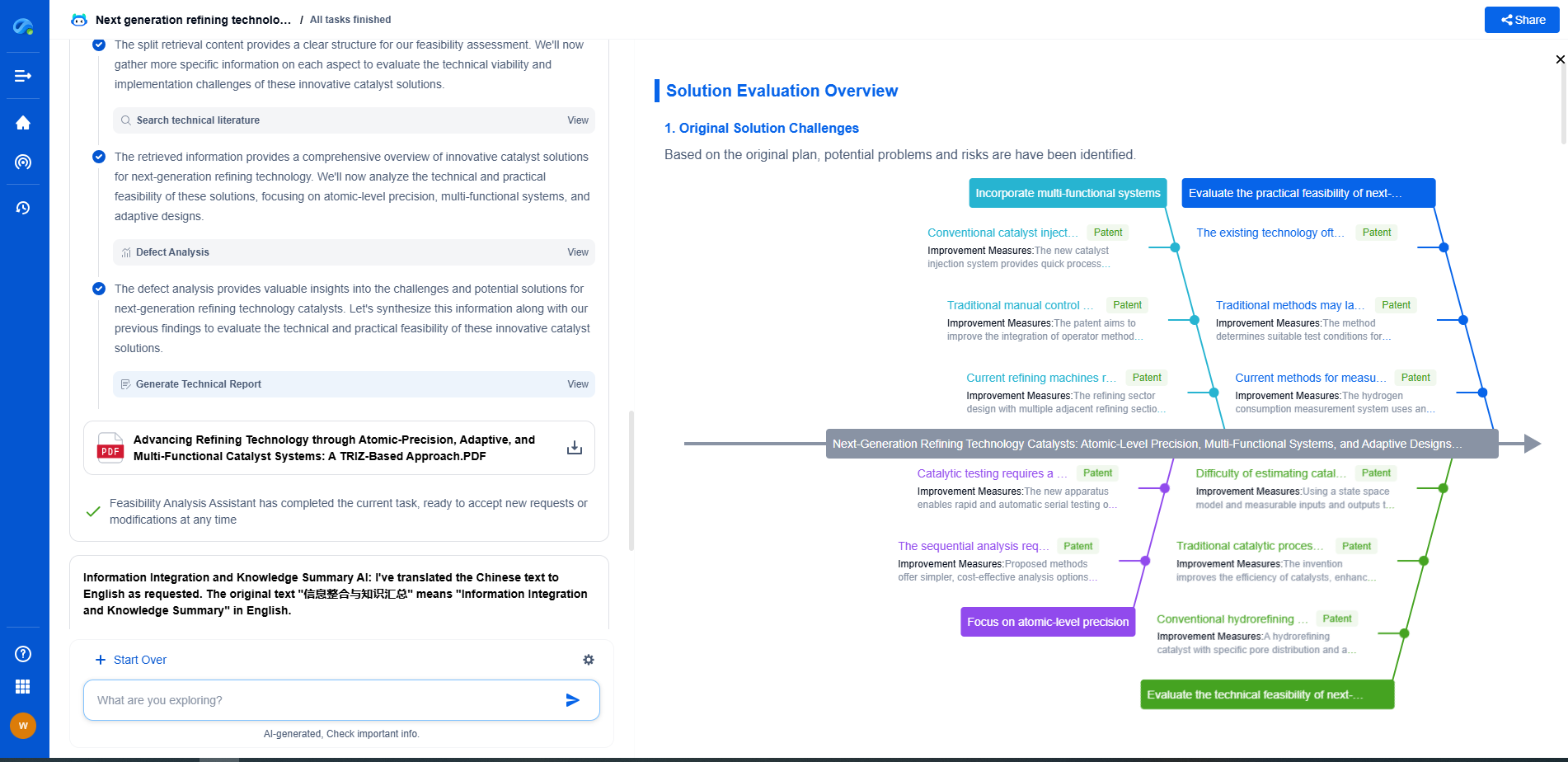The ILI Tool Selection Dilemma: MFL vs. UT vs. EMAT for API-Compliant Assessments
JUN 20, 2025 |
When it comes to ensuring the integrity of pipelines and ensuring compliance with API standards, choosing the right in-line inspection (ILI) tool is crucial. The choice between Magnetic Flux Leakage (MFL), Ultrasonic Testing (UT), and Electromagnetic Acoustic Transducer (EMAT) can be daunting, given the distinct advantages and limitations each method presents. In this blog, we'll delve into the intricacies of each technology, providing a comprehensive guide to help you make an informed decision.
Understanding the Basics of ILI Tools
In-line inspection tools are essential for assessing the condition of pipelines from the inside. These tools travel through the pipeline, collecting data on its condition and identifying any anomalies that may indicate corrosion, cracks, or other forms of damage. This data is critical for maintaining pipeline integrity and ensuring safety.
Magnetic Flux Leakage (MFL)
Magnetic Flux Leakage is one of the most widely used ILI technologies. It works by magnetizing the pipeline and detecting changes in the magnetic field caused by metal loss or other anomalies. MFL tools are particularly effective for detecting corrosion and pitting in ferrous materials.
Advantages of MFL:
1. MFL is highly effective at detecting metal loss, making it ideal for pipelines where corrosion is a primary concern.
2. It provides rapid assessment, which is beneficial for inspecting long pipeline sections quickly.
3. MFL is a well-established and trusted method with a wide range of tool options available.
Limitations of MFL:
1. It may struggle to detect smaller defects or differentiate between different types of anomalies.
2. MFL is less effective on non-ferrous materials and may require additional methods for comprehensive assessments.
Ultrasonic Testing (UT)
Ultrasonic Testing uses high-frequency sound waves to detect pipeline defects. This method is capable of providing detailed images of the pipeline's interior and is particularly effective at identifying cracks and measuring wall thickness.
Advantages of UT:
1. UT is highly accurate in measuring wall thickness and detecting cracks, making it ideal for addressing specific areas of concern.
2. It offers a high level of detail, which can aid in precise defect characterization.
3. This method is effective on a variety of materials, both ferrous and non-ferrous.
Limitations of UT:
1. UT generally requires a liquid couplant, which can complicate the inspection process.
2. The speed of UT inspections can be slower compared to MFL, potentially increasing operation time and costs.
Electromagnetic Acoustic Transducer (EMAT)
EMAT is a non-contact method that generates ultrasonic waves electromagnetically, avoiding the need for a couplant. This technology is effective in detecting both surface and subsurface anomalies.
Advantages of EMAT:
1. EMAT is ideal for environments where couplants are impractical, such as high-temperature or rough surfaces.
2. It provides a non-contact method, reducing inspection time and complexity.
3. EMAT is capable of detecting a wide range of defects, including those in difficult-to-access areas.
Limitations of EMAT:
1. EMAT technology is still evolving, and the availability of tools may be limited compared to more established methods.
2. The initial cost of EMAT tools can be higher, potentially impacting the budget for pipeline assessments.
Choosing the Right Tool for API Compliance
Selecting the right ILI tool involves considering several factors, including the specific requirements of the pipeline, the types of materials involved, and the nature of the potential defects. It's also essential to consider the API standards that must be met, as these will guide the inspection process and ensure regulatory compliance.
1. Pipeline Composition: For ferrous pipelines where corrosion is the main concern, MFL may be the best option. For pipelines with a mix of materials or where cracking is a concern, UT or EMAT might be more appropriate.
2. Defect Types: If the focus is on detecting cracks and measuring wall thickness, UT is likely the most suitable choice. For a more comprehensive defect detection approach, EMAT offers versatility.
3. Operational Environment: In environments where liquid couplants are impractical, EMAT provides a viable alternative. Additionally, EMAT's non-contact nature can be beneficial in high-temperature conditions.
Conclusion
The ILI tool selection dilemma is a complex one, with each technology offering unique benefits and limitations. Making the right choice requires a thorough understanding of the pipeline's characteristics, the types of defects likely to be encountered, and the specific API compliance requirements. By carefully considering these factors, operators can ensure that they select the most appropriate tool for their needs, maintaining pipeline integrity and safety while adhering to industry standards.
Transform the Way You Innovate in Pipeline Technology—with AI-Powered Intelligence
From corrosion-resistant materials to smart monitoring systems and advanced flow control mechanisms, the pipeline industry is undergoing rapid technological transformation. Yet keeping up with evolving engineering solutions, regulatory landscapes, and competitive patents can be a major bottleneck for R&D and IP teams.
Patsnap Eureka is your AI-powered research companion—built specifically for professionals in high-tech and infrastructure domains like pipeline technology. Whether you're designing high-pressure transport systems, assessing trenchless installation innovations, or safeguarding proprietary flow assurance solutions, Eureka provides real-time insights into global patent trends, emerging technologies, and R&D intelligence—all in one intuitive interface.
Empower your team to innovate faster, reduce technical blind spots, and stay ahead of industry shifts. Discover Patsnap Eureka today and bring clarity and confidence to your pipeline technology decisions.
- R&D
- Intellectual Property
- Life Sciences
- Materials
- Tech Scout
- Unparalleled Data Quality
- Higher Quality Content
- 60% Fewer Hallucinations
Browse by: Latest US Patents, China's latest patents, Technical Efficacy Thesaurus, Application Domain, Technology Topic, Popular Technical Reports.
© 2025 PatSnap. All rights reserved.Legal|Privacy policy|Modern Slavery Act Transparency Statement|Sitemap|About US| Contact US: help@patsnap.com

